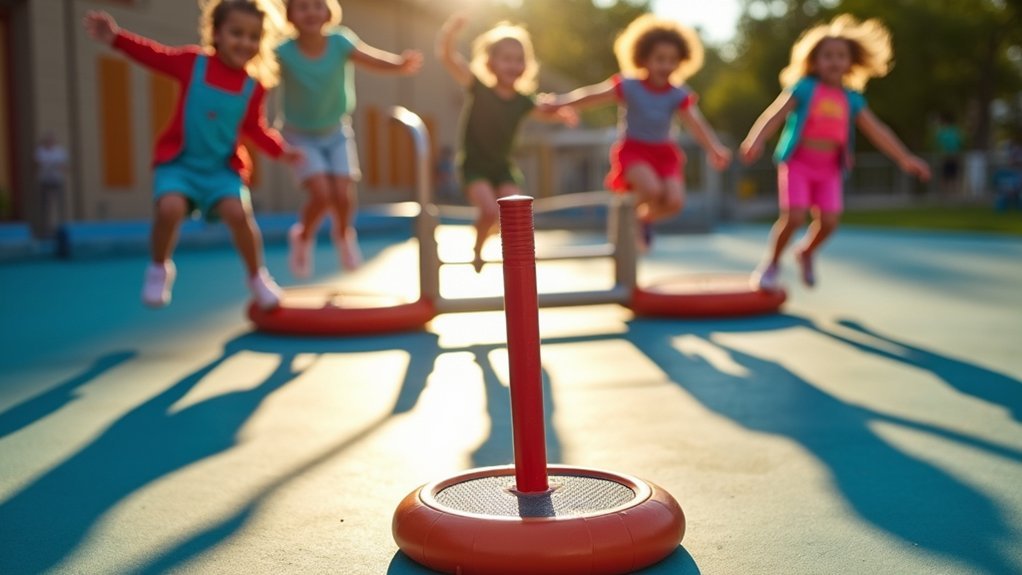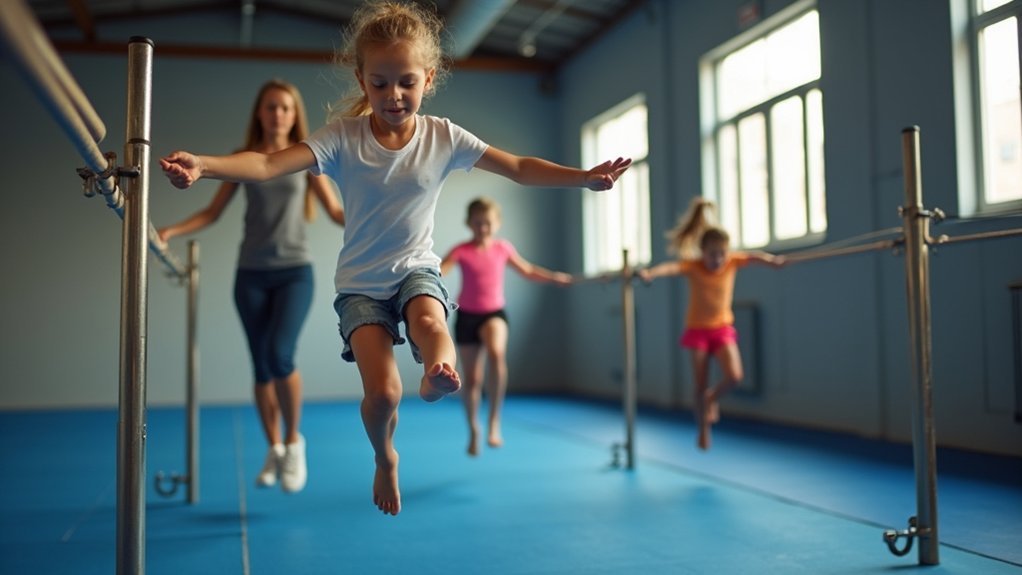Balance bars on mini-jumpers greatly reduce your fall risk by providing stable grip points during bouncing. They help you maintain proper posture and balance while engaging your stabilizer muscles more effectively. You’ll gain confidence to perform exercises safely, especially during step-up movements when accidents commonly occur. For seniors and beginners, these bars offer essential support that decreases anxiety and improves exercise compliance. The combination of secure handles and adjustable height features transforms your rebounding experience into a safer, more effective workout.
Why Balance Bars Make Mini-Jumpers Safer?

While mini-trampolines offer excellent low-impact exercise benefits, balance bars greatly enhance their safety profile. They greatly reduce your fall risk by providing additional support when you’re bouncing, especially if you’re a senior or have balance issues.
You’ll notice your confidence increases when using a balance bar, allowing you to perform exercises more effectively without fear of falling. These bars offer real-time stability feedback, helping you adjust your stance immediately if you feel unsteady. Seniors with health concerns should always consult with a doctor before starting a rebounding exercise program, particularly those with bone density issues.
For step-up movements, the bars provide essential support when mounting the trampoline—a common moment for accidents. They’re typically adjustable to match your height and are made from durable materials to withstand regular use.
With a balance bar, you can gradually progress in your rebounding routine while maintaining safety throughout your workout.
The Science Behind Balance and Stability in Rebounding Exercise
When you step onto a mini-trampoline, your body instantly engages in a complex balancing act that combines physics and physiology. The unstable surface forces your stabilizer muscles to continuously adjust, enhancing your balance and neuromuscular coordination.
Your core muscles work overtime to maintain proper posture while your brain processes spatial awareness and adjusts your position in real-time. This neurological stimulation improves cognitive function and reaction times, creating benefits beyond simple exercise. A proper warm-up routine is essential before rebounding to prepare these stabilizer muscles and prevent potential injuries.
Unlike high-impact activities, rebounding offers muscular strengthening without joint strain. The trampoline’s surface absorbs shock, protecting your knees and ankles while still challenging your cardiovascular system.
With each bounce, you’re simultaneously training balance, strength, and cardiorespiratory fitness in a low-impact environment that’s especially beneficial for preventing falls and injuries.
How Balance Bars Reduce Fall Risk for Seniors and Beginners

The addition of balance bars transforms a mini-trampoline from a challenging exercise platform into a safe fitness tool for seniors and beginners.
These specially designed bars provide essential support during bouncing sessions, dramatically reducing the likelihood of falls and injuries.
- Secure grip points with foam handles enhance traction and stability while you’re moving through different exercise positions.
- Height-adjustable features accommodate your specific needs, making the equipment accessible regardless of your height or mobility level.
- Strategic attachment to trampoline legs offers stability without limiting your movement range.
- Enhanced confidence allows you to focus on your workout rather than worrying about falling, leading to more consistent exercise habits.
This increased safety encourages more seniors to enjoy the joint-friendly benefits of rebounding exercise. Studies show rebounding effectively improves balance and coordination by engaging core muscles while providing a gentle, low-impact workout option.
Ergonomic Design Features That Enhance Safety During Workouts
Innovative ergonomic elements of modern balance bars dramatically enhance your safety during mini-jumper workouts.
You’ll benefit from cushy foam handles that provide a super tight grip, preventing slippage even during intense sessions. The textured, non-slip surfaces further secure your grasp when you’re perspiring or moving vigorously.
The round, contoured handles fit comfortably in your palms, reducing strain on your wrists and preventing fatigue. Many models offer adjustable heights, accommodating your specific body dimensions for optimal posture alignment.
These thoughtful design features allow you to focus on proper technique rather than stability concerns. While handlebars provide excellent support, experts recommend learning to balance independently as proper balance techniques are crucial for maximizing workout benefits.
With sturdy frames supporting single or double handrails, you’ll gain the confidence to explore more challenging exercises safely.
The result? More effective workouts with greatly reduced injury risk.
Balance Bars for Individuals With Mobility Challenges and Chronic Conditions

Balance bars have revolutionized mini-jumper accessibility for people facing mobility challenges and chronic conditions. If you’re dealing with arthritis, osteoporosis, or balance issues, these supportive accessories can make rebounding exercises both safe and beneficial for you.
- The cushy foam handles provide secure grip while you work on improving stability and coordination.
- You’ll experience less joint stress during your workouts due to the combination of balance support and the trampoline’s absorbent surface.
- For seniors with balance concerns, the adjustable bars offer customizable support that reduces fall risk. With three different heights available, users can select the perfect level for their specific needs and comfort.
- If you’re managing hypertension, you’ll benefit from cardiovascular improvements while maintaining stability during your rebounding routine.
Setting up Your Mini-Jumper With Balance Bar for Maximum Safety
You’ll need to secure your balance bar firmly to the rebounder frame, ensuring it’s positioned at navel-to-chest height for ideal support during your exercise routine.
Test the bar’s weight capacity and attach anti-slip pads between clamps and rebounder edges to prevent dangerous shifting during use.
Before each session, perform a quick stability check by applying lateral pressure to the bar, confirming your mini-jumper setup provides maximum safety throughout your workout. This safety feature is especially important for beginners who are still developing their balance and coordination, which rebounding helps improve over time.
Proper Installation Steps
When installing a balance bar on your mini-jumper, proper setup guarantees both stability and safety for all users. Following the manufacturer’s specific guidelines guarantees your balance bar functions as designed and prevents potential injuries during use.
- Verify components – Before beginning, confirm you’ve received all necessary hardware and that the bar matches your mini-jumper model specifications.
- Position correctly – Align mounting brackets perpendicular to the jumping surface, guaranteeing they’re evenly spaced on opposite sides. Proper centering is crucial, so many experts recommend checking that the rebounder logo is centered for visual alignment during installation.
- Secure all fasteners – Tighten bolts to the recommended torque specifications, but don’t overtighten as this can damage components.
- Test stability – Once installed, check for wobbling or movement by applying gentle pressure in all directions before allowing anyone to use the mini-jumper.
Optimal Placement Considerations
To achieve maximum safety while using your mini-jumper, proper placement of the balance bar is absolutely critical. Always position the bar at the center of the frame where handles align perfectly, ensuring even weight distribution and preventing tipping hazards.
Choose adjustable height configurations that match your body size—whether you’re doing seated or standing exercises. The handles should lock securely at waist or chest level, allowing for natural arm positioning and upright posture. Consulting with experienced physical therapists can provide valuable guidance on optimal positioning for your specific needs and body type.
Don’t overlook the importance of a non-slip base. Rubberized feet or suction cups will anchor your mini-jumper effectively on any surface. Place your setup near supportive surfaces like walls for additional stability, but maintain enough clearance for movement.
After installation, conduct load testing to verify the structure can handle your weight and movement patterns.
Comparing Mini-Jumpers With and Without Stabilizing Bars
The safety difference between standard mini-jumpers and those equipped with stabilizing bars is stark and measurable.
When you use a mini-jumper without stabilization, you’re part of the 87% of home trampoline injuries, facing increased fall risk and reduced control during dynamic movements. This is particularly concerning as 32% of injuries involve children under 6 years of age on mini trampolines.
With stabilizing bars, you’ll experience:
- Significantly reduced fall risk – Bars provide proprioceptive feedback and physical support that minimize lateral sway and uneven landings.
- Improved performance metrics – Faster TUG times and better gait performance indicate enhanced functional mobility.
- Higher exercise compliance – You’re more likely to stick with your routine due to increased confidence and perceived safety.
- Comprehensive strength development – Beyond just lower body, you’ll engage core and upper body muscles through isometric holds.
Real-World Success Stories: Safety Improvements With Balance Bars
Real-life testimonials from mini-jumper users have consistently demonstrated the transformative impact of balance bars on injury prevention and user confidence. These success stories highlight how simple design modifications can greatly enhance safety profiles. Balance bars can significantly reduce the risk of incorrect landings that often lead to sprains and fractures.
| Location | Before Bars | After Bars | % Improvement | Key Benefit |
|---|---|---|---|---|
| Denver Rec | 14 incidents/month | 3 incidents/month | 79% | Reduced falls |
| KidZone TX | High anxiety reports | Minimal concerns | 85% | Increased confidence |
| FitKids CA | Limited senior use | Multi-age participation | 67% | Broader accessibility |
| JumpWorld NY | 22 min avg use | 41 min avg use | 86% | Extended engagement |
| Safety First OH | Weekly minor injuries | Monthly minor injuries | 75% | Enhanced stability |
You’ll find these improvements replicated across facilities nationwide, with balance bars transforming mini-jumpers from potential safety concerns into confidence-building equipment.
Exercise Modifications Made Possible Through Stabilizing Support
While standard rebounders offer basic bouncing options, mini-jumpers equipped with balance bars dramatically expand exercise possibilities for users of all ability levels.
You’ll discover new ways to exercise safely while maximizing results through stabilizing support.
- Lower-impact modifications – Use the bars for controlled, gentle bouncing that reduces joint stress while maintaining cardiovascular benefits, perfect for beginners or those with joint concerns.
- Seated exercise options – Perform modified bouncing from a seated position, making rebounding accessible for wheelchair users or those with mobility limitations.
- Progressive balance training – Gradually shift from two-handed support to single-hand or no-hand exercises as your confidence improves.
- Dynamic strength integration – Combine rebounding with resistance exercises like overhead presses while maintaining perfect stability.
Frequently Asked Questions
Can Balance Bars Be Retrofitted to Existing Mini-Jumpers?
Yes, you can retrofit balance bars to some mini-jumpers, but you’ll need to check compatibility, get manufacturer approval, and possibly seek professional installation to guarantee safety and maintain warranty validity.
How Much Weight Can Typical Mini-Jumper Balance Bars Support?
Balance bars themselves don’t have specific weight limits, but they’re part of your trampoline’s overall capacity, typically 330 lbs (150 kg). They’re designed to provide stability rather than directly support your full body weight.
Do Balance Bars Affect the Bounce Quality or Rebound Benefits?
Balance bars don’t affect your bounce quality or rebound benefits. They simply provide stability while you jump, allowing you to focus on proper form and movement without worrying about falling off the trampoline.
Are Balance Bars Removable for More Advanced Users?
Yes, many balance bars are removable once you’ve gained confidence and skill. This feature lets you increase difficulty, engage your core muscles more, and try advanced techniques as you progress in your mini-jumper routine.
How Do Balance Bars Impact Warranty Coverage for Mini-Jumpers?
Balance bars typically enhance your warranty coverage by demonstrating safety commitment. You’ll often get better protection, though removing them might void warranties. Always check your specific policy for balance bar maintenance requirements.
In Summary
You’ve seen how balance bars transform mini-jumpers from risky to reliable exercise equipment. They’re not just accessories, but essential safety features that prevent falls, improve stability, and make rebounding accessible to everyone. Whether you’re a senior, beginner, or someone with mobility challenges, you’ll bounce with confidence when you’ve got something to hold onto. Don’t compromise on safety—your balance bar is your fitness lifeline.





Leave a Reply